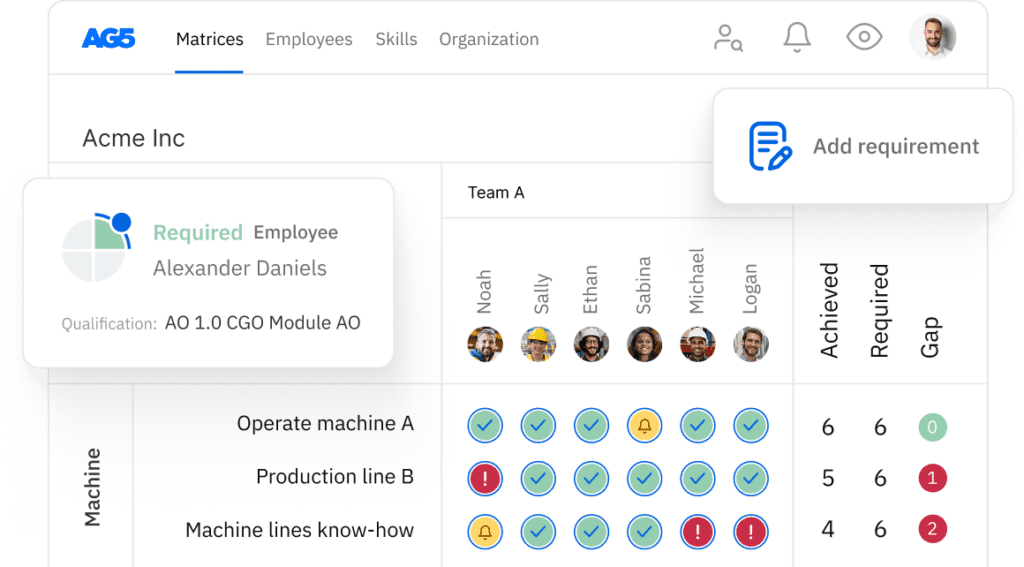High performers: How to identify them in your organization
During this article we dive into the art of identifying high performers in your organization. Unlock strategies to recognize and nurture top talent for exponential growth.

High performers are extremely important to the success of every organization. They’re the employees who can do more or are always prepared to go the extra mile. But how do you recognize your high performers? And how do you make the most of their special qualities?
Types of employeesCopied
Employees come in all shapes and sizes, and each type of employee brings their own set of skills and attributes to the workplace. Here are just a few of the different types of employees you might encounter:
The go-getter: this type of employee is always on the go, striving to be the best. They’re competitive and driven and always looking for new challenges.
The innovator: this type of employee is always thinking outside the box. They’re creative and resourceful and always looking for new ways to do things and get things done.
The independent thinker: this type of employee is analyzing and evaluating. They like to solve problems independently, and they’re always looking for new ways to improve things.
High performers are the cream of the crop—the ones who consistently exceed expectations and are willing to contribute significantly to your company’s bottom line. Average performers meet your expectations most of the time, but they don’t necessarily stand out in the crowd. And finally, low performers are those who consistently underperform and often require extra supervision or coaching to meet minimum standards.
What is a high performer?Copied
A high performer (or high achiever) is someone who excels within an organization. They virtually always perform beyond expectations and are often willing to go the extra mile to achieve an objective.
Managers approach these people first whenever there’s a difficult or challenging job in the pipeline because they have a proven track record of success. In other words, they’re your star players.
Are they the same as high potentials!Copied
The term ‘high performer’ is often confused with the term ‘high potential’. The latter refers to people who have shown above-average talent and have the potential to progress into a role as a high performer.
So effectively, it’s an earlier stage in professional development. Someone with high potential can become a high performer with enough effort and the right mentoring.
How to identify high performersCopied
Many organizations fail to capitalize fully on high performers because they don’t recognize them early enough. Consequently, they don’t pay enough attention to their professional development and before you know it they’ve left the company in search of bigger challenges.
But it’s not all that difficult to spot high performers if you know what you’re looking for.
You can often spot high performers because they …
- act as role models – they inspire others and encourage them to perform at a higher level (consciously or subconsciously)
- tackle difficult situations – they see challenges as opportunities to grow both personally and professionally
- pay attention to processes – they don’t only focus on the results
- think innovatively – they search for ways to improve operational processes and achieve additional growth
- enjoy their work – they experience high levels of job satisfaction
- dare to make decisions – they’re not scared to make the jump or sometimes make mistakes
- value input and feedback – they view feedback as a way to learn and improve still further
- have large and valuable networks – they know that maintaining good business relations with other professionals is the key to success
- adapt quickly and effortlessly – they go with the flow when faced with new working environments, operating procedures, or staff reorganizations
- seek autonomy and challenging work – they perform well qualitatively and quantitatively

Which tools to use to identify your high performersCopied
It’s always important to use the right tools for any job, and this applies to identifying your high performers. The three strategies we’ve outlined below have proven particularly effective:
1. Use key performance indicators (KPIs)
Using a good set of key performance indicators (KPIs) is the first step toward identifying your high potentials and high performers. They help determine whether your organization and its employees are on course to achieving your objectives.
The right KPIs for identifying high performers should ideally take the following factors into consideration. They should be clearly defined and easy to implement. Both staff and managers should fully understand what a given KPI is actually measuring. By limiting the number of KPIs and defining them clearly and accurately, you’ll know exactly which criteria to use to identify high performers.
What’s more, KPIs aren’t static. By this, we mean that they may change in response to internal developments, the economic climate, or competitive influences. That’s why it’s important to review and – if necessary – revise your KPIs to ensure you can identify your high performers in any situation.
Sometimes, it’s advisable to create counter-KPIs. For example, the number of telephone calls per hour is an important KPI for a telemarketer. But simply making calls without any measure of quality is meaningless. It’s wise to link other factors such as ‘customer satisfaction levels’ or ‘conversion rates’ to the number of calls made.
2. Conduct a 360° review
360° reviews are a great way to evaluate staff performance. They take information from a wide variety of sources, for example feedback from line managers, direct reports, co-workers, and customers, to paint a complete picture of someone’s personality and performance. This is the key to spotting and managing talented individuals.
You can implement these reviews in several ways. You could have staff complete questionnaires or keep logbooks. Alternatively, you could pass out questionnaires on the shop floor. It’s advisable to keep feedback as anonymous as possible to encourage people to be as non-biased and honest as possible.
3. Use skills management
Skills management is also a great way to recognize talent. Using skills matrices or skills management software, you can create a snapshot of all your staff’s skills, competences, and qualifications – quickly and easily.
They make it much easier to identify staff members who have a high number of core skills or progressing rapidly with their professional development. In practice, it would be virtually impossible to overlook a high performer, which then allows you to take appropriate action to keep them in your company.
Find top performers with the AG5 Expert FinderCopied
Top performers achieve high scores for their skills. The AG5 Expert Finder allows you to identify top performers based on specific criteria. After using it, you will be provided with a list of employees ranked in order from top performer, most qualified, and/or most talented for your specific purpose.
Contact us today to learn how skills management software can help your business thrive.

